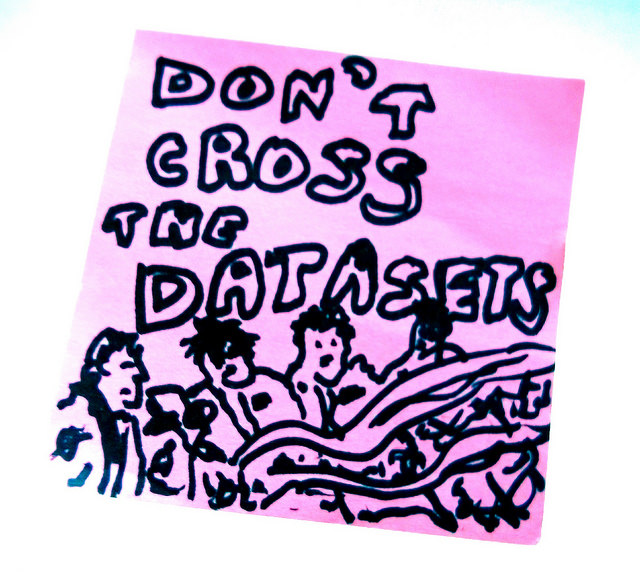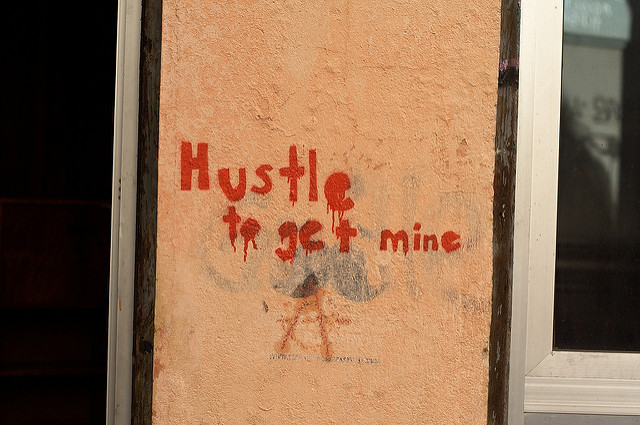|
|
|
Archive for the 'Ducks In A Row' Category
Monday, March 4th, 2019

Poking through 11+ years of posts I find information that’s as useful now as when it was written.
Golden Oldies is a collection of the most relevant and timeless posts during that time.
Jerks, by whatever name, have been on the rise for awhile, but that seems to have escalated in the last couple of years, especially in the workplace. Not that jerk bosses are anything new, but they are getting more blatant.
Read other Golden Oldies here.
Although both articles I refer to are aimed at startup founders, I believe they are applicable to bosses at any level and in any company.
First, no boss ever accomplished their goals by being a jerk.
As Bob Sutton explains in The Asshole Survival Guide, treating people like dirt hurts their focus and saps their motivation. (…)
In the podcast, Reid [Hoffman] describes his test of a great culture: Does every employee feel that they personally own the culture?
Most jerks, no matter how unlikely that the comparison is valid, point to Steve Jobs to justify their actions, but consider how much more he could have done if he had been a better leader/manager..
It’s hard to find any boss who doesn’t recognize that culture is the most critical element in a company’s success.
However, what “culture” is has been twisted and warped out of all recognition.
These days “cultural fit” is the excuse of choice to indulge whatever biases, prejudices, and bigotry moves the hiring boss.
So, what does cultural fit really mean?
To answer that you have to understand what culture really is.
Culture is a reflection of the values of the boss.
Values have nothing to do with perks, food, or office buildings and everything to do with attitudes such as fairness, merit, transparency, trust, etc.
The point of cultural fit is to hire people whose personal values are, at the least, synergistic with the cultural values of the company.
Period.
That means that if the boss is biased, bigoted or a jerk, they will hire people who have similar values.
Image credit: Matthias Forster
Posted in Culture, Ducks In A Row, Golden Oldies | No Comments »
Tuesday, February 26th, 2019

Ryan’s solution to getting angry is to respond after he’s slept; the vp in yesterday’s post went somewhere private to cool down before responding.
Both work, but there’s a third way.
The non-tech world already figured it out and the tech world is starting to admit that “move fast and break things” isn’t the smartest approach.
However, there is one good time to break things, although moving fast is optional.
That’s when you’re seriously angry and what may break is you.
Not good.
Instead, break a thing.
Contrary to what a lot of professionals tell you, hitting a ball or even a punching bag, no matter how hard, doesn’t always help.
Why? Because when all is said and done, hitting [whatever] is constructive, not destructive
And destructive feelings are usually immune to constructive action.
Smashing something is different.
Glasses or crockery — dishes, bowls, cups — work best and they’re cheap at garage sales and thrift shops.
The only caveat is to smash safely.
The easiest way is to get a really deep large box (the kind from a washer, dryer, etc.) and smash whatever you are using in that. If it’s too tall to throw straight down stand on a stool.
The important thing is to be able to throw really hard — smash as opposed to break.
First, focus your mind on your anger.
Then focus on the item you plan to smash and transfer your anger to the object.
Then smash it.
The goal is to destroy the feelings along with the object.
The number of items depends on the quantity of anger.
Best of all, it works.
I know.
I had a smashing station in my garage for years.
I don’t need it anymore.
Image credit: Ruth Hartnup
Posted in Ducks In A Row, Personal Growth | 1 Comment »
Tuesday, February 19th, 2019

Receiver Larry Fitzgerald, entering his 15th season, said this is the advice he’d like to give rookies.
God gave you two ears and one mouth for a reason. Listen twice as much as you talk. You learn a lot more when you’re listening.
Wally Bock quoted the same thing in a recent post.
Describing a manager who made a major hiring error that went uncorrected, I commented , that he couldn’t hear and wouldn’t have listened anyway.
Of course, it’s easier to talk than listen.
And you can’t really listen if you are looking at your phone.
Or doing anything on your computer.
Or thinking about where to go to lunch or what to make for dinner.
Or thinking about what you want to say as soon as the other person shuts up.
In other words, you can’t listen, really listen if you’re multitasking.
I might end this post with Wally’s high-level, positive summing up.
Listening is a critical leadership skill you can master. It will help you learn about the people you work with, demonstrate you think they’re important, and help you make better decisions.
But my take is low-level simple.
Knowing and practicing good listening is a great way to avoid being the lead character in Bob Sutten’s book The No Asshole Rule.
Image credit: Alan Goudy
Posted in Communication, Culture, Ducks In A Row, Personal Growth | No Comments »
Tuesday, February 12th, 2019
 Have you ever wondered why bias is so deeply ingrained and prevalent? Have you ever wondered why bias is so deeply ingrained and prevalent?
The answer is simple.
The datasets are biased.
For humans
Psychologists from Northwestern University have found that children as young as four show signs of racial bias, suggesting they pick up on cues to act intolerant from the adults around them from a very early age.
For AI.
The digital world is an incredibly biased place. Geographically, linguistically, demographically, economically and culturally, the technological revolution has skewed heavily towards a small number of very economically privileged slices of society.
Knowing the datasets for both are biased for the same reason, it is the wise boss, from team leader to CEO, who takes time to learn their own biases and also understand the various biases of their team.
Only then can they develop approaches and work-arounds.
The bottom line in business is that you don’t have to change minds, you just have to create processes that neutralize the effects.
Image credit: Paul Downey
Posted in Culture, Ducks In A Row, Personal Growth | No Comments »
Tuesday, February 5th, 2019

Two facts
- Google hires a lot of people
- Google is very good at algorithms
So why not use the latter to solve the former?
It doesn’t work.
Google is known for hiring really smart people, so why not use brain teaser questions to identify them.
It doesn’t work.
Analytics can make a difference if your company is large enough.
AI may help, but its bias, the result of biased data sets, means a high cost in missed candidates.
It also means more time to hire and more money spent, because you will be chasing the same people as everyone else.
Like it or not, your staffing is dependent on the hiring skills of your managers.
There is no staffing gene; people aren’t born knowing how to hire anymore than they are born knowing how to manage.
It’s your responsibility to make sure they learn both.
Image credit: Otota DANA
Posted in Ducks In A Row, Hiring | No Comments »
Tuesday, January 29th, 2019

Yesterday’s Oldie talked about one of the biggest lies perpetrated on an already vulnerable Millennial audience — relentless striving 24/7.
It’s a great article — equal parts enlightening and alarming.
Welcome to hustle culture. It is obsessed with striving, relentlessly positive, devoid of humor, and — once you notice it — impossible to escape.
According to Erin Griffith (@eringriffith), writing in the New York Times, the biggest drivers perpetuating the scam do so to line their own pocket.
“The vast majority of people beating the drums of hustle-mania are not the people doing the actual work. They’re the managers, financiers and owners,” said David Heinemeier Hansson, the co-founder of Basecamp.
In 2016 Marissa Mayer, of Yahoo infamy, claimed a person could work 130 hours a week was possible “if you’re strategic about when you sleep, when you shower, and how often you go to the bathroom.”
Many companies extoll the approach and incorporate it into their culture, but WeWork has gone further and built its business around it and is a good example of how this philosophy in action looks more like a cult than a culture.
It has exported its brand of performative workaholism to 27 countries, with 400,000 tenants, including workers from 30 percent of the Global Fortune 500.
But it took Gary Vaynerchuk, the patron saint of hustling and founder of One37pm to “glorify ambition not as a means to an end, but as a lifestyle.”
It’s a lifestyle that has made a fetish of convenience, not for the sake of a better, more well-rounded life, but as a way to free up more time to work.
Finally, without doubt, it can be stated that hustle is a culture with no redeeming features. It sucks humanity from its followers, then uses up and destroys the most devout.
Image credit: Hermann Kaser
Posted in Culture, Ducks In A Row, Personal Growth | No Comments »
Tuesday, December 11th, 2018

Do you hire based on grades and/or the college attended?
If so, give yourself an F — for being a hiring dinosaur and ignoring the data.
Way back in the 1980s, when I was a tech recruiter, one of the best/smartest engineering vps I ever worked with told me he didn’t care about GPAs or college attended. He said that the value of a technical degree lost approximately 20-25% of its value each year, because the tech world changed so fast.
He also said that grades were more the result of a good memory and the ability to regurgitate information on demand than actual knowledge.
Fast forward to Adam Grant’s most recent column. Grant is one of the smartest people I read and I read a lot. Not because he has a PhD, but because he has more common sense than almost any other three (four? five?) combined.
The evidence is clear: Academic excellence is not a strong predictor of career excellence. Across industries, research shows that the correlation between grades and job performance is modest in the first year after college and trivial within a handful of years. (…)
Academic grades rarely assess qualities like creativity, leadership and teamwork skills, or social, emotional and political intelligence.
Take a good look at that list. It encompasses all the skills that bosses, no matter their level, claim they want, but frequently pass on.
Why? Because candidates with those qualities don’t as easily “fit” into rigidly framed jobs.
Whereas one thing that can be said for straight A students is that they are expert at coloring inside the lines, so are usually easier to manage.
Getting straight A’s requires conformity. Having an influential career demands originality.
“Valedictorians aren’t likely to be the future’s visionaries,” Dr. Arnold explained. “They typically settle into the system instead of shaking it up.”
Moreover, hiring with the assumption that you can reshape their embedded code when it is convenient for you is totally unfair and sets you both up for frustration, at the least, or outright failure.
This might explain why Steve Jobs finished high school with a 2.65 G.P.A., J.K. Rowling graduated from the University of Exeter with roughly a C average, and the Rev. Dr. Martin Luther King Jr. got only one A in his four years at Morehouse.
So the when you go to fill your next opening give serious thought to what you are really looking for.
Image credit: Adam Grant
Posted in Ducks In A Row, Hiring, Personal Growth | No Comments »
Tuesday, November 27th, 2018

In the intro to yesterday’s post, about how boredom often triggers creativity, I referred to the hoops being jumped through to foster creativity in the workplace.
Unfortunately, it’s not working and that’s what to day’s post is about.
You may have noticed that creativity is all the rage—and not just among artists. American culture, and indeed the world, has become obsessed with manufacturing creative kids, who will turn into inventive workers, who will then become the innovative leaders we need in these rapidly-changing times. (…) As creativity is increasingly touted as the “premiere skill” of our time, [Diane] Senechal argues, there’s little interest in just letting this ability develop independently. Instead, it is being quantified, dissected and tested, taught and measured.
That approach may work on some talent, but developing creativity isn’t one of them.
In reality, that approach does more to destroy creativity than almost anything else.
The enormous number of major discoveries grounded in serendipity should be enough to convince people that structure and pressure don’t work.
If institutions really want to encourage creativity, in other words, they’ll have to develop the requisite patience to wait for it—and the ability to recognize what inventiveness is really made of. Insisting on innovation will never work, according to Senechal. “Perhaps the worst thing for creativity is dogma,” she argues. “Dogma delights in nothing; it insists on its own rigid ways.”
Of course, humans are notorious for believing they can improve any process by structuring it — even when it goes against research and proven results.
Bottom line, if you want your people to be more creative you need to let go, not hold on.
Image credit: Rigby Financial
Posted in Culture, Ducks In A Row, Personal Growth | No Comments »
Tuesday, October 9th, 2018

Way back, when I was a recruiter, I coined a term for an attitude that impacted people from senior ranks down through support staff and production workers.
I called it ego-merge and it happened when people so entwined their identity with their company’s that they took personal responsibility for its successes and failures.
Last week we looked at companies with perks designed to keep people on site, so that the company becomes their life.
Both situations are highly addictive.
Even companies with benefits designed to foster better work-life integration/balance can be considered addictive, since they are difficult to leave.
Most addictive of all are great managers, even when special perks and over-the-top benefits are missing.
Sadly, abusive companies/managers are also addictive, just as abusive homes/partners/relatives are.
So what do you do if both good and bad can be addictive?
Know yourself.
Know what’s really important to you, not to your friends or what looks cool on social media.
Make a list.
Know what holds your company has on you.
Make a list.
Compare the lists.
Revisit each list at least once a year, more often if something major happens in your life or company.
Edit them based on who you/company are, not who you/company were.
Image credit: David Prasad
Posted in Culture, Ducks In A Row, Personal Growth | No Comments »
Tuesday, October 2nd, 2018

I’ve made my own hiring errors, as have we all (anyone who claims otherwise is lying).
So when interviewing, we have a few company-wide mantras (for lack of a better term) to guide us.
I find this one goes a long way to ensuring we don’t get caught up in people’s past, rather, it helps us focus on attitude and potential.
“The main ingredient of stardom is the rest of the team.” — John Wooden, basketball player and coach
Look at all the people who were stars at places like Goldman Sachs or Google, such as Marissa Meyer, or GE’s Bob Nardelli (who nearly destroyed Home Depot), who were unable to maintain their level of performance outside the culture, systems and management of that specific company.
That’s why it’s always dangerous to hire stars — more than anything else they are a product of their environment.
Image credit: Lee Haywood
Posted in Culture, Ducks In A Row, Hiring | No Comments »
|
 Subscribe to
Subscribe to
MAPping Company Success
About Miki 
Clarify your exec summary, website, etc.
Have a quick question or just want to chat? Feel free to write or call me at 360.335.8054
The 12 Ingredients of a Fillable Req
CheatSheet for InterviewERS
CheatSheet for InterviewEEs™
Give your mind a rest. Here are 4 quick ways to get rid of kinks, break a logjam or juice your creativity!
Creative mousing
Bubblewrap!
Animal innovation
Brain teaser
The latest disaster is here at home; donate to the East Coast recovery efforts now!
Text REDCROSS to 90999 to make a $10 donation or call 00.733.2767. $10 really really does make a difference and you'll never miss it.
And always donate what you can whenever you can
The following accept cash and in-kind donations: Doctors Without Borders, UNICEF, Red Cross, World Food Program, Save the Children
*/
?>About Miki
About KG
Clarify your exec summary, website, marketing collateral, etc.
Have a question or just want to chat @ no cost? Feel free to write
Download useful assistance now.
Entrepreneurs face difficulties that are hard for most people to imagine, let alone understand. You can find anonymous help and connections that do understand at 7 cups of tea.
Crises never end.
$10 really does make a difference and you’ll never miss it,
while $10 a month has exponential power.
Always donate what you can whenever you can.
The following accept cash and in-kind donations:
|















